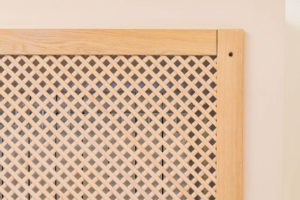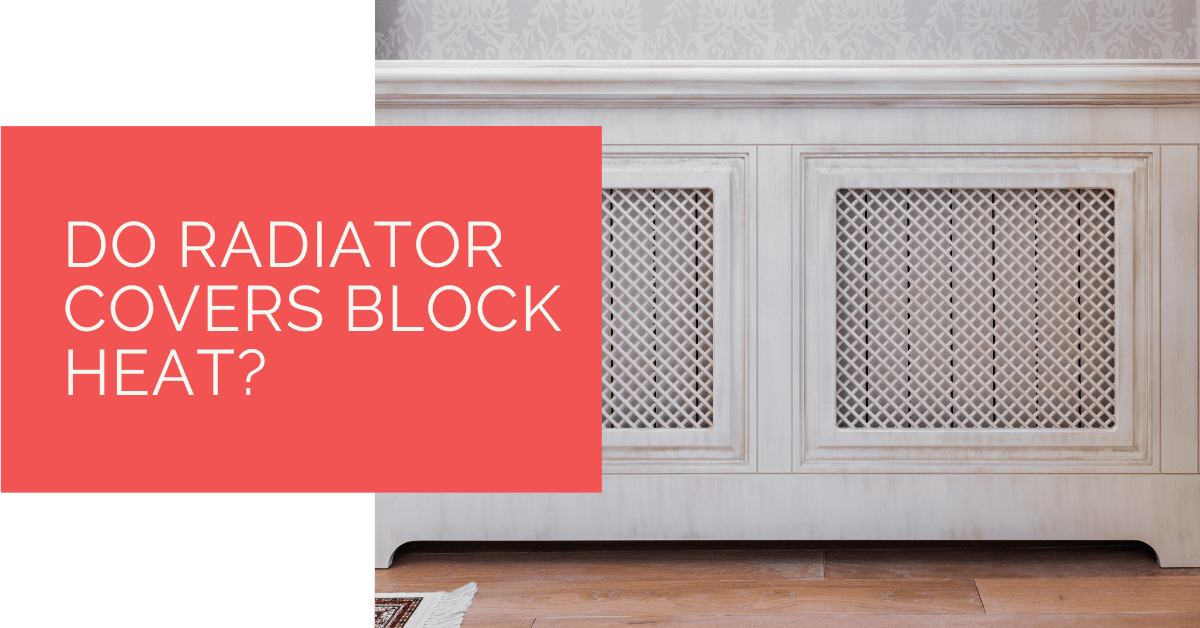Radiator covers are back in style in the UK, but do they decrease the radiator’s ability to create heat? This article investigates the value of purchasing a radiator cover and other advantages. Keep reading to know more.
Contents
- 1 Key Takeaways
- 2 What Are Radiator Covers?
- 3 How Do Radiators Generate Heat Output?
- 4 Different Types of Radiators Covers
- 5 Why Should You Buy a Radiator Cover?
- 6 Do Radiator Covers Block Heating Efficiency?
- 7 Can There Be Any Heat Loss due to Radiator Covers?
- 8 Determining an Appropriate Gap between the Radiator and Its Cover
- 9 Pros of Using Radiator Cover
- 10 Cons of Using a Radiator Cover
- 11 Heat Pump Source: Reliable Heating and Cooling Solutions
- 12 Wrapping Up
Key Takeaways
- Radiator covers are primarily used for safety, ornamental purposes, and extra storage, and they can be an alternative to replacing a radiator.
- Radiator covers may reduce heat output slightly due to acting as a barrier, but they typically allow heat to escape through holes and slots, maintaining efficiency.
- Benefits of radiator covers include safety for children, extra shelf space, improved energy efficiency, and noise reduction, but potential downsides include heat loss and additional cost.
What Are Radiator Covers?
Radiator covers are the covering for a heating system. Covers are primarily used for heat protection for children and pets, ornamental purposes, and extra storage. Radiator covers are an excellent alternative to purchasing a new radiator for those who don’t have the time or means to do a complete retrofit.
How Do Radiators Generate Heat Output?
Radiators generate heat in three ways: radiation, natural convection, and conduction.
Radiant heat creates a sense of comfort, like holding one’s hands before a fireplace in winter. It does not immediately heat the cold air but rather travels in parallel lines of energy that are only converted to heat once they come in touch with your body or the radiator cover.
When heated, air expands and becomes less heavy, resulting in convection heating. This air rises, and colder air displaces it with the help of gravity. As heated air rises, it distributes its heat and heats the air that is not near the heating source. The greater temperature of your radiator or heat source, the greater distance the convection current would convey heat.
Conduction is heat flowing through solid things and is the slowest technique for transporting heat. If you heat one end of a piece of metal, the other one will slowly get hot, similar to what occurs if you keep a rod in a fire. It may take some time, but the heat will finally transport through the full piece of metal.

Different Types of Radiators Covers
A radiator cover is made from a variety of materials such as string, cane, medium density fiberboard, ceramics, wood and more. However, ensuring that your radiator cover does not impair heat output is critical. As a result, radiator covers made of insulating materials capable of preventing heat from radiating should not be purchased.
Why Should You Buy a Radiator Cover?
Well-made radiator covers improve efficiency and may assist you in reclaiming lost space, protecting your household from the risks of hot radiators, and reducing noise. It is a small but effective way to freshen up a room. Furthermore, solid radiator covers may boost heat efficiency.
Do Radiator Covers Block Heating Efficiency?
Placing any solid item surrounding your heat source may reduce heat output since it serves as a barrier. But a radiator cover will not trap too much heat as it contains holes and slots, allowing heat to escape and warm the air by convection. This reduces efficiency of the radiator.
If your radiator’s cover is totally solid, you will lose heat and energy, making your boiler work harder to attain the ideal temperature set up by your thermostat.
Can There Be Any Heat Loss due to Radiator Covers?
If you use an inadequate radiator cover, the barrier may alter how evenly warm air distributes throughout the living space. However, it is avoidable because radiator cover performance varies depending on the type, design, and material.
Determining an Appropriate Gap between the Radiator and Its Cover
It is essential to ensure enough room between the radiator and its cover to maintain your radiator’s performance. Here are the advised proportions for correct measurements. Just make sure the covers are at least as big as your radiators.
- 40 mm wide
- 30 mm Height
- 20 mm deep
Before making any purchase decision, it is critical to analyse the advantages and downsides of radiator covers. Continue reading to understand the necessity and function of a radiator cover properly.

Pros of Using Radiator Cover
With so many varying perspectives on their usefulness and necessity, deciding whether or not to install radiator covers in your home can be difficult. However, covering a radiator provides more benefits than being an energy-saving method or a stylish addition to your home.
Protection for the Family
The heat from radiators can be a dangerous addition to any home, especially if you have young children around. In such cases, radiator covers are critical for childproofing your radiators. Although installing a low surface temperature radiator can be difficult and time-consuming, many individuals prefer to do so since they are less expensive than regular radiators.
A radiator cover is a less expensive and more appealing alternative in this case. A radiator cover’s functionality is to reduce burn injuries that can occur when the heat from the radiator is too high by blocking reachability to the radiator.
Many radiator covers provide access through the front panel, allowing you to reach the radiator as needed without exposing it to youngsters and pets running around the house. Electric sockets can also be installed on the radiator cover to keep curious little hands and feet away from them.
Extra Shelf Space
Because many radiator covers are designed to seem like beautiful cabinetry, they also provide additional shelving space. The interior of the radiator cover cabinets is small, but there is plenty of space on top.
This allows you to display all of your decorations and family photos! You can make your radiator cabinet into a functional yet visually beautiful piece of furniture for your home.
Energy Efficient
Radiator covers promote an equitable distribution of heat and increase energy efficiency in your home if supported efficiently and adequately. Nothing can reduce the heat output of the radiator as long as the radiator cover has evenly distributed ventilation openings that also function as a design element.
The heat held within the radiator cover cabinet is gradually released through ventilation holes in the front panels, allowing you to keep your house warmer for longer while using less energy.
Noise Reduction
A cover can silence the majority of radiator noises. It will ensure that louder noises are muted, regardless of whether the pipes are banging or pouring.
However, you should be aware that any noise made by your radiator should be investigated. In case of a problem, get a cover that is easier to remove in order to provide access to the heating unit.

Cons of Using a Radiator Cover
Benefits of radiator cover are many, but they have various technical downsides that should be examined before purchasing. Here are a few things to know about that can cause you problems:
The Possibility of Heat Loss
A poorly constructed radiator cover might cause heat loss. Anything that hinders airflow reduces a radiator’s efficiency. Some radiator covers can also trap heat, causing your thermostatic radiator valve (TRV) to read incorrectly and causing your central heating system to malfunction.
To avoid this, try purchasing a cover with enough space in its design to allow heat to escape.
The Cost
Many homeowners prefer not to spend money on unnecessary stuff. The added expense of a radiator cover may not seem all that appealing, especially if you’re on a tight budget.
Although professional coverings are likely to be both safer and more effective when purchasing radiators with the goal of covering them, there are workarounds, including creating your version.
Heat Pump Source: Reliable Heating and Cooling Solutions
At Heat Pump Source, we take pride in our unwavering commitment to serving the UK with top-tier HVAC solutions. From the efficiency of heat pumps and the cool relief of air conditioning to the warmth of boilers, radiators, and underfloor heating, our dedicated team is always at the forefront of innovation. We understand the unique needs of every household and business, and we strive to provide dependable health and cooling products and services that are tailored just for you. Ensuring your comfort and satisfaction is our utmost priority. Whether you have questions, need guidance, or require support, we’re always here to assist. Please don’t hesitate to contact us; we’re eager to be of service.
Wrapping Up
Radiator covers are not only decorative but also functional. By concealing the radiators, they protect children from burning their fragile fingertips. If you first identify the area in which you want your radiator to fit, calculating the distance between it and its cover is equally simple.
About the Author
At Heat Pump Source, our articles are the product of a collaborative effort among a team of highly skilled HVAC experts. Our dedicated professionals, hailing from diverse backgrounds in heating, ventilation, air conditioning, and refrigeration, contribute their extensive knowledge and experience to every piece of content. This multidisciplinary approach ensures comprehensive coverage. Our commitment is to deliver authoritative, reliable, and tailored advice to meet the unique needs of every household and business across the UK.

